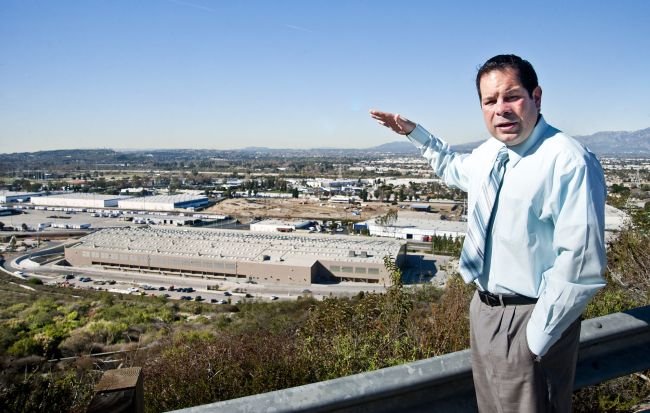https://www.sgvtribune.com/ci_
For more than two decades, local trash engineers have been planning for the day when the Puente Hills Landfill near Hacienda Heights would close, and thousands of tons of municipal garbage would ride the rails to Imperial County.But the $450 million trash train, also known as waste-by-rail, is being derailed by a sluggish economy. The dream of San Gabriel Valley cities seeing all their stinking garbage leave the Valley for a landfill in the middle of nowhere is likely to be postponed, officials at the county Sanitation Districts said last week.
It’s a matter of economics. Because it costs so much more to operate the trash train than to handle it at a growing number of private local landfills, and because the sluggish economy means we are producing significantly less trash, the county agency that manages solid waste may make cheaper arrangements for our trash’s final resting place come Oct. 31, 2013, the day the Puente Hills Landfill will close.
“It doesn’t mean we are giving up on waste-by-rail. It means it would be delayed until the economy recovers,” said Robert Ferrante, who heads the solid waste management department at the Sanitation Districts in North Whittier.
Yes, the county has built a Puente Hills Material Recovery Facility near the landfill, partially in preparation for the train. And yes, it is putting the final touches on a truck-to-train “intermodal” facility, complete with its own underpass beneath Workman Mill Road between Industry and Whittier so heavy-ladened container trucks can pass freely into a special train yard. And yes, the whole operation – including the 250-mile train trip to the completed Mesquite Regional Landfill – will be ready to go by February 2013, Ferrante said.But the $450 million system may not be needed – at least not for the foreseeable future.
“Instead, we will look for a closer landfill – we want to operate in the most cost-effective way,” he said.
The numbers are the best way to illustrate this story.
Without any subsidizing by the Sanitation Districts, it will cost about $80 a ton in what’s called a tipping fee for trash that travels on waste-by-rail, as opposed to $38.41 now to bury it in Puente Hills above the 60 Freeway. Also, the cost of reusing green waste – lawn clippings, tree branches, garden trimmings – is scheduled to rise once the landfill closes, Ferrante said.
The county agency charges very low rates for haulers who take this waste in a separate truck from the curb to the landfill where it is mulched and used as cover instead of the agency importing expensive dirt.
The rise in tipping fees for trash, and the added cost of finding new uses for green waste such as composting or biogas conversion, most likely will be passed on to the homeowner, apartment owner and commercial owner’s trash bills. How much will trash bills go up? Ferrante could not make a guess.
But there’s no doubt they would go up much quicker and much higher without the county Sanitation Districts’ cost-levelization plan. The agency has been saving money from tipping fees to smooth out the impact of waste-by-rail’s true cost.
However, the Great Recession has eaten into those funds, Ferrante explained at a conference attended by 120 city and industry types on Monday.
As trash levels dropped, so did tipping revenues. “We are not developing the funds we had hoped for,” he said.
The law of supply and demand intervened.
In 2005, the county was burying 45,000 tons of trash per day. In 2001, that number dropped to 29,000.
“The numbers began to drop off in 2007. We lost new construction and demolition. L.A. County has lost one-third of its trash generation,” Ferrante explained.
At Puente Hills, once the largest landfill west of the Mississippi, the tonnage dropped from a high of 13,200 a day to what it is today – 5,000 tons per day, he said.
As supply dropped, competition rose. Private trash companies like Republic Services, Waste Management, Waste Connections and others began building or expanding their own landfills and setting their own tipping fees.
Several nearby landfills make for desirable – and much closer in – options than waste-by-rail once Puente Hills closes, Ferrante said. For example, El Sobrante Landfill in Corona, operated by Waste Management, may actually want the San Gabriel Valley’s trash. Likewise, Republic Service’s Sunshine Canyon Landfill near Sylmar – one of the nation’s largest, taking in 9,500 tons of trash daily – could claim local trash streams. And there’s plenty of others that have recently expanded and, like Puente Hills, have seen a drop in tonnage because of the economy. But unlike Puente Hills, are not shutting down.
“The market is more competitive now. It is a disposal buyer’s market. We’re seeing the rates actually dropping,” Ferrante said.
Ferrante said when Puente Hills closes, all its tonnage could easily be absorbed by in-county and near-county landfills “without the need to go to waste-by-rail.” He said the change from a “landfill capacity crisis” in the late 1980s and 1990s to an open market could not have been foreseen.
Whittier Councilman Greg Nordbak, who chairs the Sanitation Districts Board of Directors, said the market is in play.
“Private enterprise will drive it. And we will have to do what is most economical,” he said.

